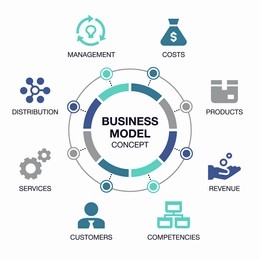A **business model** is a company’s plan for making a profit. It identifies the products or services the business plans to sell, its identified target market, and any anticipated expenses. Business models are important for both new and established businesses.
They help new, developing companies attract investment, recruit talent, and motivate management and staff. Established businesses should regularly update their business model or they’ll fail to anticipate trends and challenges ahead. Business models also help investors evaluate companies that interest them and employees understand the future of a company they may aspire to join.
There are dozens of types of business models including retailers, manufacturers, fee-for-service, or freemium providers. The two levers of a business model are pricing and costs. When evaluating a business model as an investor, consider whether the product being offered matches a true need in the market.
Here are Some Examples of Business Models:
- **Retail**: Brick-and-mortar store: Physical store selling products directly to customers.
- **Franchise**: Licensing of a recognized brand and business model to individual entrepreneurs.
- **Manufacturing**: Mass production: Large-scale production of standardized products. Custom manufacturing: Tailoring products according to specific customer requirements.
- **Fee-for-service**: A business model where a company charges a fee for a specific service.
- **Freemium**: A business model where a company offers a basic service for free, but charges for premium features.
It’s important to note that successful businesses have business models that allow them to fulfill client needs at a competitive price and a sustainable cost. Over time, many businesses revise their business models from time to time to reflect changing business environments and market demands.
How Do You Choose the Right Business Model for your Company?
Choosing the right business model for your company is a crucial decision that can impact your success. Here are some steps to help you choose the right business model:
- **Identify your target market**: Determine who your customers are and what they need. This will help you identify the products or services you should offer.
- **Research your competitors**: Analyze your competitors’ business models to identify their strengths and weaknesses. This will help you determine how you can differentiate your business from theirs.
- **Evaluate your resources**: Assess your company’s resources, including your team, technology, and finances. This will help you determine which business model is feasible for your company.
- **Determine your revenue streams**: Identify how you will generate revenue from your products or services. This will help you determine which revenue model is best suited for your business.
- **Test your business model**: Before launching your business, test your business model to ensure it is viable. This will help you identify any potential issues and make necessary adjustments.
- **Regularly review and update your business model**: As your business grows and evolves, your business model may need to change. Regularly review and update your business model to ensure it remains relevant and effective.
What is the Difference between a business model and a revenue model?
A **business model** and a **revenue model** are two different concepts. A business model is a company’s plan for making a profit.
It identifies the products or services the business plans to sell, its identified target market, and any anticipated expenses.
Business models are important for both new and established businesses. They help new, developing companies attract investment, recruit talent, and motivate management and staff.
Established businesses should regularly update their business model or they’ll fail to anticipate trends and challenges ahead. Business models also help investors evaluate companies that interest them and employees understand the future of a company they may aspire to join.
On the other hand, a **revenue model** is a company’s plan for generating revenue from its products or services. It describes how a company earns money from the value it has generated for customers.
Revenue models are typically used to develop an existing product or service. A revenue model provides the specifics of how the company will collect money from its customers. It is an important component of the business model.
In summary, a business model provides a framework for how the business will make money, while a revenue model provides the specifics of how the company will collect money from its customers.
What are some Common Mistakes to Avoid when Choosing a Business Model?
When choosing a business model, here are some common mistakes to avoid:
- **Failing to research your options**: It’s important to research and evaluate your options to ensure you make the best decision for your business.
- **Focusing on short-term, rather than long-term plans**: A business model should be designed to be sustainable in the long run.
- **Considering tax advantages alone**: While tax advantages are important, they should not be the only factor considered when choosing a business model.
- **Keeping it casual with multiple owners**: It’s important to have a clear agreement in place with all owners to avoid conflicts down the line.
- **Ignoring market trends**: It’s important to stay up-to-date with market trends and adjust your business model accordingly.
What are some examples of successful business models?
Many successful business models have been implemented by companies. Here are some examples:
- **Servitisation (subscription) business**: Instead of selling a product or a service as a one-off, servitisation companies operate on a subscription or ongoing service model, building a more intimate understanding of their customers in the process. Examples include Netflix and Dollar Shave Club.
- **Platform-based business**: Platforms provide a mechanism or network for parties to interact with each other. Examples include Facebook, GitHub, Uber, and Airbnb.
- **Social, authentic business**: Customers want to see the people behind the brand; they want to really “connect” with a business. Authentic businesses share their opinions and stand up for their values. Examples include Patagonia and Ben & Jerry’s.
- **Freemium**: A business model where a company offers a basic service for free, but charges for premium features. Examples include LinkedIn and Dropbox.
- **Retail**: Brick-and-mortar store: Physical store selling products directly to customers. Examples include Walmart and Target.
Remember, choosing the right business model is critical to the success of your company. Take the time to research and evaluate your options to ensure you make the best decision for your business.
Do not hesitate to ask us about solving problems in the Business Model. We may be the decisive step in your life. Contact us now, or follow up on our social media
Facebook, LinkedIn, Instagram



